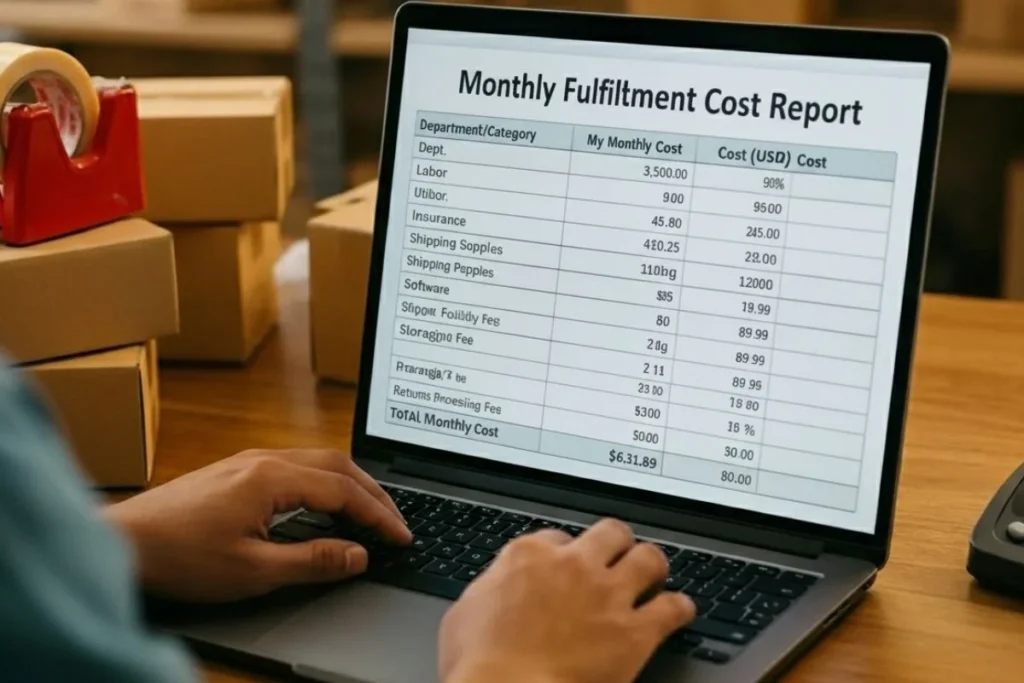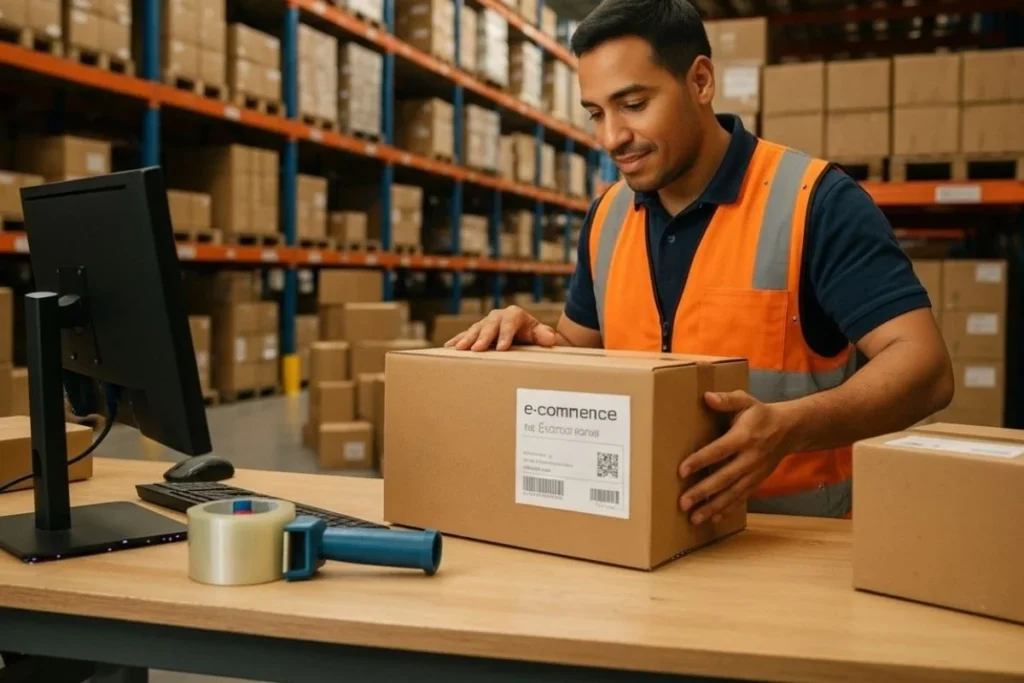Are fulfillment costs draining your e-commerce profits? Most online retailers are unaware that these expenses typically consume 70% of your total fulfillment budget or about 10–30% of average order value.
Your profit margins depend on knowing exactly how to calculate fulfillment costs for each order. Most e-commerce businesses underestimate these expenses by 20-30%, missing warehouse storage fees, pick-and-pack labor, packaging materials, and return processing costs that quietly eat into profits.
The Components of Fulfillment Costs
Before calculating costs, you need to understand what makes up your total fulfillment expenses. There are two types of fulfillment costs: fixed and variable.
These fixed and variable costs determine your actual fulfillment expense per order. Break them down separately, and you’ll identify the cost drivers that hurt your profitability most.
Fixed Fulfillment Costs
Fixed costs remain relatively constant regardless of your order volume. They form the baseline expense of your fulfillment operation.
These include warehouse rent or mortgage, facility maintenance, utilities, insurance, inventory management salaries, and technology systems like your Warehouse Management System (WMS). Even if you ship zero orders in a month, you’ll still incur these expenses.
For businesses using third-party logistics providers, fixed costs might include minimum monthly fees, account management fees, and technology integration costs.
Variable Fulfillment Costs
Variable costs change with your order volume. The more orders you ship, the higher these costs go.
These include picking labor (retrieving items from storage), packing labor (preparing items for shipment), packaging materials, shipping fees, and handling returns.
Variable costs also include seasonal labor during peak periods and overtime pay during periods of high volume. These expenses show your actual per-order profitability.

The Basic Formula for Calculating Fulfillment Costs
The fundamental equation for determining your total e-commerce fulfillment costs is straightforward but requires careful tracking of all expenses:
Total Fulfillment Cost = Fixed Costs + Variable Costs
To calculate your cost per order, which is often more useful for analysis:
Cost Per Order = Total Fulfillment Cost ÷ Number of Orders
For most e-commerce businesses, the average fulfillment cost per order typically ranges from $3 to $15, depending on product characteristics and business specifics, according to OpenSend. In Mexico, local fulfillment providers may offer lower per-order costs.
Breaking Down Each Cost Component
Warehousing and Storage Costs
Storage expenses are typically calculated based on the space your inventory occupies. This can be measured in various ways depending on your storage provider.
On average, 3PL providers charge about $20 per pallet per month for storage, with common rates ranging from $15 to $40 depending on location and service levels. For smaller items that don’t require full pallets, storage is typically billed by volume, averaging around $0.46 per cubic foot.
If you manage your own warehouse, start by dividing your total facility costs by the usable square footage to calculate your cost per square foot. Then, determine the space each product occupies to allocate storage costs accurately.
Labor Costs for Order Processing
Labor costs are a significant portion of fulfillment expenses, and they include the cost of workers who pick, pack, and ship your orders.
To calculate labor costs per order:
- Track the total hours spent on fulfillment activities
- Multiply by the average hourly wage (including benefits)
- Divide by the number of orders processed
Shipping and Carrier Fees
Shipping costs vary dramatically based on package dimensions, weight, destination, and service level. That’s why most businesses struggle to predict these expenses accurately.
Most 3PLs offer shipping discounts ranging from 10% to 30% off standard carrier rates. However, some may add markups of 0-12% over negotiated rates.
To estimate your average shipping cost:
- Track total shipping expenses over a representative period
- Divide by the number of packages shipped
- Segment by shipping zones, if possible, for more detailed analysis
EP Logistics’ e-commerce fulfillment services can help optimize these costs through strategic inventory placement and carrier rate negotiations.
Packaging Materials and Supplies
Packaging costs include boxes, mailers, tape, dunnage (void fill), and any custom-branded materials you use.
To calculate per-order packaging costs:
- Track total packaging material expenses
- Divide by the number of orders shipped
- Add a small percentage for waste and damaged materials
Consider both standard and custom packaging options. While custom packaging enhances brand experience, it typically costs 15-40% more than standard options.
Returns Processing Costs
Returns can significantly impact your fulfillment costs, especially in categories with high return rates like apparel. Calculate returns processing costs by:
- Tracking labor hours dedicated to processing returns
- Adding the cost of return shipping (if you offer free returns)
- Including any restocking or disposal costs for damaged items
- Dividing by the number of returns processed
Multiply this figure by your return rate to determine the average return cost per order.
Hidden Fulfillment Costs to Consider
Peak Season Surcharges
During high-volume periods, such as the holiday season, carriers frequently impose surcharges, which can increase shipping costs by 15-30%.
These temporary increases typically apply from October through January but may vary by carrier. Consider these surcharges when developing seasonal promotions and pricing strategies.
Additionally, you may need temporary staff during peak periods, which increases labor costs and often comes with higher training expenses and lower productivity.
Long-Term Storage Fees
Slow-moving inventory increases storage costs over time, especially with 3PLs that charge increasing rates for items stored above certain thresholds.
For example, standard storage fees for fulfillment providers typically range from $0.45–$0.75 per cubic foot per month, according to OpenSend. However, long-term storage fees can be 2-3 times higher.
Regularly review inventory turnover rates and consider liquidating or discounting slow-moving products to avoid these escalating costs.

Account Management and Technology Fees
Technology integration and management fees are often overlooked when calculating fulfillment costs. These include:
- WMS subscription fees
- Integration costs with your e-commerce platform
- EDI (Electronic Data Interchange) setup and maintenance
- Account management fees from 3PLs
- One-time setup fees, which average $425 according to Red Stag Fulfillment
While these costs may seem minor individually, they can add up to a significant portion of your fulfillment budget.
In-House vs. Outsourced Fulfillment Cost Comparison
Deciding whether to handle fulfillment in-house or outsource to a 3PL requires a comprehensive cost comparison. Each approach has distinct advantages and cost structures.
To accurately compare in-house and outsourced fulfillment, create a spreadsheet that includes all relevant costs for each option:
For in-house fulfillment:
- Warehouse lease or mortgage
- Utilities and maintenance
- Labor (including benefits and management)
- Equipment (forklifts, packing stations, etc.)
- Technology systems
- Packaging materials
- Shipping (without 3PL discounts)
- Insurance and security
For 3PL fulfillment:
- Storage fees
- Pick and pack fees
- Shipping costs (with 3PL discounts)
- Account management fees
- Integration costs
- Special project fees
- Returns processing
Remember to factor in the opportunity cost of managing fulfillment in-house versus focusing on core business activities like product development and marketing.
Strategies to Reduce Fulfillment Costs
Inventory Distribution Optimization
Strategic inventory placement can significantly reduce shipping costs and delivery times. Consider distributing inventory across multiple fulfillment centers to minimize the distance to customers. This approach, called distributed inventory, reduces shipping zones and costs
For businesses shipping internationally, EP Logistics’ logistics solutions with cross-border expertise can help optimize inventory placement between the US and Mexico, reducing duties and transportation expenses.
Negotiating Better Carrier Rates
Shipping typically represents 40-70% of total fulfillment costs, making carrier rate negotiation essential for cost reduction. Strategies for securing better rates include:
- Consolidating shipping volume with fewer carriers
- Using 3PL negotiated rates
- Comparing rates across multiple carriers for each shipment
- Using zone skipping for large volume shipments
- Negotiating based on annual shipping volume projections
Even a 5% reduction in shipping rates can translate to significant savings across thousands of orders.
Fulfillment Cost Calculator
To simplify the process of calculating your fulfillment costs, use this basic formula and adapt it to your specific business needs:
Monthly Fulfillment Cost = Fixed Costs + (Variable Cost Per Order × Number of Orders)
For a more detailed calculation, create a spreadsheet with the following components:
- Fixed Costs Section:
- Warehouse rent/mortgage
- Utilities
- Management salaries
- Technology systems
- Insurance
- Variable Costs Section:
- Picking labor per order
- Packing labor per order
- Packaging materials per order
- Average shipping cost per order
- Returns processing (as % of orders)
- Order Volume Section:
- Monthly order forecast
- Average items per order
- Return rate percentage

This calculator will assist you in estimating fulfillment costs based on different order volumes and determining which components have the greatest impact on your overall cost.
Making Data-Driven Fulfillment Decisions
Understanding your true fulfillment costs is essential for making informed decisions about your e-commerce operations. By breaking down each component and identifying hidden expenses, you gain valuable insights that can drive profitability.
Remember that fulfillment isn’t just a cost center; it’s a critical part of the customer experience. The goal isn’t necessarily to minimize costs at all costs, but to optimize the balance between expense and service quality.
Whether you choose in-house fulfillment or partner with a 3PL like EP Logistics, accurate cost calculation provides the foundation for strategic decision-making. As your company grows and market conditions shift, review your fulfillment costs on a regular basis to ensure your strategy remains optimal.



